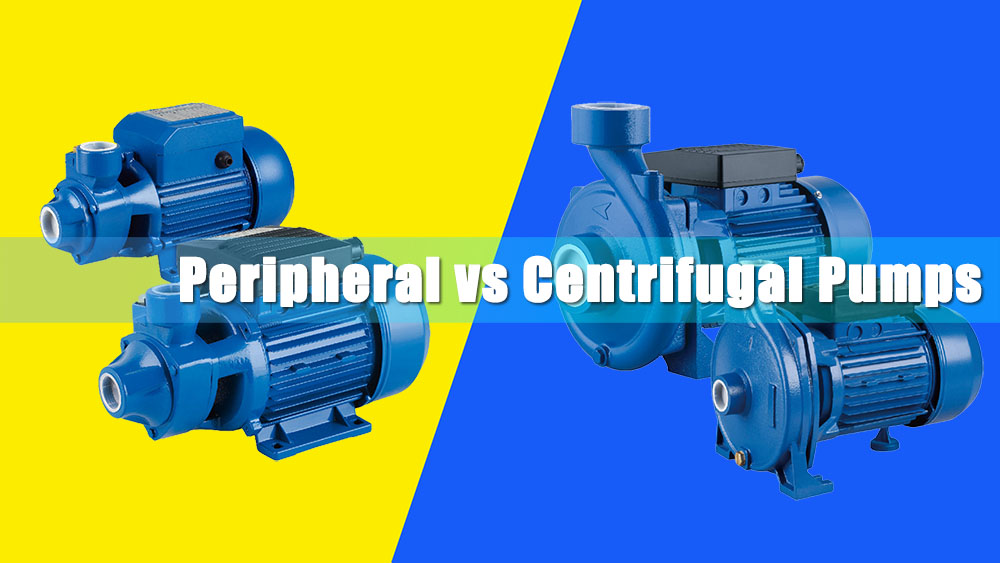+86 13816508465
Pump Knowledge
Jul. 22, 2025

Efficient water delivery is essential for residential systems, especially when water pressure needs a boost to meet household demands. Whether it’s powering showers, appliances, or backyard irrigation, choosing the right pump type can make a significant difference. Two common options for home water boosting are peripheral pumps and centrifugal pumps.
This guide breaks down the unique characteristics, benefits, and applications of each pump type, empowering installers, project buyers, and distributors to make informed decisions for their residential water systems.
Understanding Peripheral Pumps
Peripheral pumps, also known as vortex pumps or side channel pumps, generate pressure through a unique vortex effect. Water enters the impeller's side channels, where it experiences rapid rotation that increases the pressure. This design makes peripheral pumps capable of producing high-pressure output despite their compact size.
Key Characteristics of Peripheral Pumps
High Pressure, Low Flow
Peripheral pumps excel at generating high pressure, making them ideal for applications requiring forceful water delivery without the need for a significant flow rate.
Compact Design
These pumps are small, lightweight, and easy to install, which is valuable when space is a constraint.
Clean Water Dependency
Peripheral pumps perform best with clean water, as debris can clog the narrow channels.
Boosting water from rooftop tanks to provide pressure for showers and faucets
Enhancing water delivery in single-family homes with limited space
Point-of-use installations for dedicated appliances
Understanding Centrifugal Pumps
Centrifugal pumps operate through the rotational force of an impeller, which directs water outward from the center to generate flow. This efficient mechanism allows centrifugal pumps to handle larger water volumes at moderate pressure levels, making them highly versatile.
Key Characteristics of Centrifugal Pumps
Higher Flow, Moderate Pressure
Centrifugal pumps are designed to transport substantial water volumes with consistent, moderate pressure output.
Adaptability to Water Quality
These pumps can handle water with small amounts of debris, depending on the design.
Horizontal Configuration
Most centrifugal pumps require more space due to their horizontal layout, but their efficiency often compensates for it.
Typical Applications of Centrifugal Pumps
Garden and lawn irrigation
Circulation systems for residential swimming pools
General water supply needs for larger properties
To make a practical choice, it helps to directly compare the strengths and weaknesses of both pump types:
Feature | Peripheral Pump | Centrifugal Pump |
Pressure Capability | High (ideal for small, pressurized systems) | Moderate (suitable for volume-based needs) |
Flow Rate | Low flow | High flow |
Impeller Technology | Vortex side channels | Radial impeller |
Water Quality Needs | Clean water only | Tolerates some debris |
Noise Level | Noisier | Generally quieter |
Size and Footprint | Compact, space-saving | Larger, requires more room |
Price | Affordable upfront | Varies by capacity and purpose |
Maintenance | Less tolerant to debris, leading to potential clogs | Requires less frequent cleaning depending on water quality |
Identifying the best pump for your application often depends on factors like pressure needs, water volume, and space availability. Here are scenarios where each pump shines:
When to Choose a Peripheral Pump
High Pressure, Low Flow Needs
For households where powerful water pressure is required (such as boosting water for showers), peripheral pumps are unmatched.
Space Constraints
Peripheral pumps’ compact size makes installation feasible even in tight spaces.
Clean, Stable Water Sources
Use these pumps where water is filtered and free of debris, preventing clogs.
When to Choose a Centrifugal Pump
High Flow Requirements
Systems that move large volumes of water, such as lawn irrigation, benefit from centrifugal pumps.
Versatile Water Quality Handling
If water sources may contain small debris, centrifugal designs are more forgiving.
Larger Footprints
With sufficient space, these pumps deliver reliable results while accommodating bigger flow demands.
When selecting between these pumps, it’s critical to balance functionality with long-term efficiency. Here are some practical tips for decision-making:
Matching Pump Specifications to Needs
Review household requirements for both pressure head (how high the water needs to be pushed) and flow rate. Peripheral pumps are ideal for demanding pressure at single points, while centrifugal pumps suit continuous, high-volume needs.
Energy Efficiency and Operational Costs
Although peripheral pumps are typically more affordable upfront, centrifugal pumps may offer better energy efficiency for large-scale, continuous operations. Over time, this can result in cost savings.
Maintenance and Durability
Peripheral pumps require cleaner water and frequent inspections to avoid blockages. Centrifugal pumps, while generally rugged, still need routine maintenance to perform optimally.
Regional Demand Trends
Different regions may favor one type of pump based on local water quality, system standards, or typical household layouts. For example, peripheral pumps dominate in areas with compact urban homes, while centrifugal pumps are common for properties with large gardens or swimming pools.
Both peripheral pumps and centrifugal pumps play important roles in residential water systems—there’s no universal solution that fits all scenarios. The ultimate choice depends on balancing specific system requirements, available space, cost considerations, and operational demands.
Choose Peripheral Pumps for high-pressure, low-flow needs and applications where compact installation is key.
Opt for Centrifugal Pumps when your priority is high water volume with moderate pressure, particularly in irrigation and circulation systems.
Expert Tip: Partner with reputable manufacturers or distributors to evaluate the best pump solution for your project before making a purchase. Always consider technical specifications and consult local guidelines to ensure compatibility and effectiveness.
Address
No.17 XeDa Jimei Ind. Park, Xiqing Economic Development Area, Tianjin, China
Telephone
+86 13816508465
QUICK LINKS